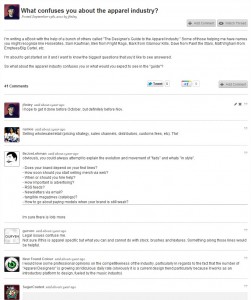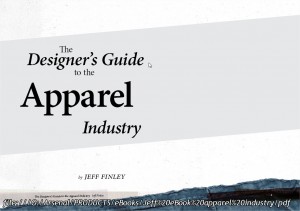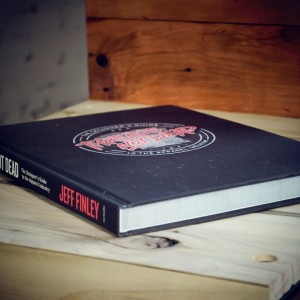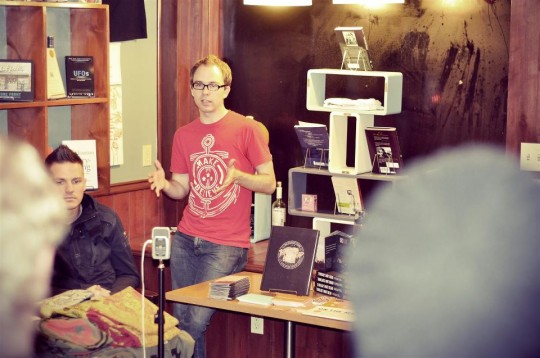Blog

The Making of Thread’s Not Dead
It’s been about 8 months since I launched my first ebook entitled Thread’s Not Dead: The Designer’s Guide to the Apparel Industry. We’ve sold over 1,000 copies of the ebook and we recently celebrated the launch of the hardcover edition. It gives me goosebumps to think of my book sitting on the coffee tables or bookshelves of people across the country and even overseas. I wanted to take a little bit of time to tell the story about how Thread’s Not Dead came to be and hopefully it will inspire you to maybe make your own book or do something you’ve been holding back on.
The Conception
The idea to write a book came to me after reading Tim Ferriss’ book The Four Hour Workweek. If you’ve read it, you know how appealing he can make some of his suggestions! He makes it sound so easy. From what I recall, “all you had to do” is figure out that specific thing you know a lot about, write the book, and sell it digitally on your website. The point was to be specific. Everyone can be an expert in something right? According to Ferriss, in order to be an expert, you just have to know more than the person reading it. He also made it sound easy when he said to reach out to other experts, interview them, and use their answers as content for your book and give them a cut of the sales. He literally made it seem like the book would write itself.
Boy was he wrong though!
The Production
I totally underestimated the time it would take to produce Thread’s Not Dead. First, choosing a topic for me was easy – I know a lot about designing t-shirts and have written tutorials here and made video tutorials of my process. I already had an audience that would be interested, so it was a no-brainer. An in-depth guide on everything I know about designing for bands and clothing companies and eventually starting your own line would be a natural progression. I had lots of “expert” contacts in this area from my time on Emptees/Mintees that I was one email away from solid nuggets of insight in areas I wasn’t totally familiar with (like printing, retail, etc). From the very start I was amped and saw myself releasing a digital ebook in less than a month.
It took about 9 months instead.
Before I started writing, I researched ebooks. I read guides on how to make good ebooks and provide real value. I also paid $97.00 for a copy of “How to Launch the Shit Out of your eBook”. That’s an affiliate link by the way, but I highly recommend that book anyway. It got me seriously inspired, despite it being the most expensive ebook I ever bought.
When I started writing, I kept getting ideas of what I should put into the book. What about the printing process? What about working with big bands? What about working with overseas production houses? How much to charge for my shirts? For my designs? The questions never seemed to end, so I reached out to my “expert contributors” and posted on Emptees (RIP) asking what they wanted to know the most. Of course, questions were all over the board and there were quite a few things I didn’t actually know the answer to. So I had to do a lot of research and reading. If I was going to write the definitive guide to the apparel industry, I better know what I’m talking about!
What I quickly realized is there is WAY TOO MUCH that goes into the apparel INDUSTRY that I’m totally unfamiliar with. I had to admit to myself that I couldn’t feasibly write the freaking bible of the industry as a whole. I was overwhelmed and getting burnt out already and I had just started writing.
But I don’t give up easily so I limited my focus to just the indie t-shirt design scene where there really are awesome stories to tell. Bands and indie clothing companies made up a lot of my clientele and most of my peers from the community were just like me. I started envisioning Thread’s Not Dead to be the book that came out of this scene and shined a light on the underground movement of this sub-genre of the apparel industry.
Everyone wants to know how to be the next Johnny Cupcakes. The idea of starting your own clothing company was cliche already, but the desire to do so hasn’t been going away. People continue to do it and it’s reached a point where having a line of tees on the side is just “another thing” that artists and designers do as part of their brand. I knew my audience was mostly artists and graphic designers, not fashion tycoons. So once I narrowed my focus, the writing became much easier.
Surviving Burnout
I tried to write the book at my desk at Go Media which included all my conveniences and distractions like Twitter, Facebook, Email, and oh yeah, clients and running a business. I’d write for 15 minutes then jump into email, then write a little more and get distracted again. Meetings, phone calls, and my general laziness sometimes got the best of me. Writing a book is NOT a short thing you can do in a couple hours, it took months of writing and editing. So I had to find tricks to keep myself focused.
Focusing Tricks
There’s this other computer that we have in our office that’s hooked up to our scanner. It’s a really old PC with Windows XP still on it. It had no distracting apps and was away from my comfort zone, so every morning I brought my coffee and headphones to this new desk and zoned out.
I actually discovered focus apps like Focus Booster and Ambiance to create some zen-like sounds in my headphones to cancel out office chatter. My goal was to write for 20 minutes a day at the very beginning of every day before I did anything else. This worked like a charm! What actually ended up happening was I would get in a zone and end up spending 2-3 hours writing before I even realized it. I didn’t even think about emails or twitter or shit like that. Sorry to swear, but seriously I hate that stuff sometimes. It’s like a drug.
I did this for a few months and had Thread’s Not Dead completely written in Microsoft Word. My ebook was done! Ahhh, not so fast Jeff, this looks like every other piece of crap ebook out there. That’s what I thought to myself. Former Threadless CCO Jeffrey Kalmikoff told me that the book should be designed well, as it’s for designers. That made total sense to me, so my work wasn’t done yet!
Designing the Layout
I knew the book had to look better than any ebook you’ve ever seen. Since I was planning on charging $50 for it, it’d better look like $50. And my design reputation is on the line here, I can’t let a product with my name on it go out into the market looking like crap, so my internal quality quotient wasn’t being satisfied. Since I didn’t know InDesign very well, I asked a few of my peers for tips and pointers and I eventually checked out the book layout templates on Graphic River. I purchased a template which gave me a good starting point for my general layout.
I honestly won’t go too in depth here because I literally stumbled my way through this process and it was really painful. I made the mistake of using low-res images because I thought it’d only be viewed on screen and not in print, but as you know I ended up putting out a hardcover edition which required a complete overhaul of everything I did. I wanted to put cool art on every page and inspire people with the images that inspired me. I wanted to make this book a work of art in and of itself. I found a local designer named Kathy Kovacic who helped me tremendously convert my ebook into a print-ready book file. The cover art was of course my favorite thing to do, which is when I decided on the name Thread’s Not Dead.
Coming up with the Name
For the longest time my working title was simply “The Designer’s Guide to the Apparel Industry.” Which was probably ok, but I wanted a snappier name with more of a personality. Most of my favorite authors’ books had shorter, catchier titles but I worried because most ebooks I know tend use a more literal “How to XXXXXX” title. So I dug deep and had a ton of different names for the book including cute ones like “Ink, Cotton, Cash” and “Don’t Thread on Me” to the more direct “How to Become a Famous T-Shirt Designer” or the extreme salesy approach “How to Dominate the Apparel Industry and Get Rich and Famous Doing So.”
I decided on Thread’s Not Dead because it’s a reference to Punk’s Not Dead, the common phrase you might see spray painted on brick walls in the 80’s when everyone was crying about the death of punk rock. My book takes a very DIY approach and I’ve been into punk since I was a teenager, so I felt like it fit with my personality. Not only that, but it was a reference to the fact that starting an apparel line has been considered cliche by many designers in the community and many consider it to be a fad. Much like punk rock was in the 80’s. But the truth is, we’re seeing the democratization of the apparel business just like we’ve seen it in the music business. Personal t-shirt lines are popping up everywhere and we’ll all eat our words in the next decade as the t-shirt still hasn’t gone out of style.
Selling the eBook
When the book was finished, I had to come up with a plan to sell this thing. We already have a platform on The Arsenal to sell digital files, but I wanted to create it’s own site dedicated to it. One single page with the sole purpose of selling the book. With my knowledge of designing landing pages to sell products, I knew we’d get more sales this way than simply uploading it to our crowded storefront on the Arsenal. So I designed the site from scratch and used ejunkie to handle the payments and deliver the digital files.
Prior to launching the site, I created a temporary landing page with LaunchRock to build an email list of people interested in buying the book. So when I launched the book I’d have people already waiting to buy. This is a good plan when launching any product, an ebook especially. Don’t just launch your ebook without any sort of pre-launch hype or promotion. All this stuff is discussed in that How to Launch the Shit Out of Your Ebook guide I linked to above. Without reading these tips I probably would have rushed the release of this thing and not made as much of an impact. In fact there are lots of things I am not doing and have never done because I simply don’t have time to write accompanying blog posts related to every section in my book or guest post on apparel industry related blogs. I try, but there is only so much time in the day. But if you make your ebook, these are good strategies to keep in mind!
The Audiobook and Extras
One thing that makes digital products cool is you can bundle it with other digital files and provide extra value. If I was going to charge $50 for this ebook, I’d better make it worthwhile. So I grabbed a bunch of our Arsenal products like vectors, textures, and t-shirt mockup templates and bundled it with the book. In addition, I spent the time narrating every chapter to create an audiobook version. (my preferred method lately for consuming books) My colleague and former-bandmate-turn-sound-engineer Adam Wagner recorded and edited it for me and my buddies in the pop punk band Spraynard let me use their music. Some have told me they’ve listened to the audiobook over 5 times and it continues to inspire them. This makes me happy because that’s how I feel when I listen to some of my favorite authors. I love hearing from people who valued what I had to say and I love even MORE to see people make cool stuff as a result. Anyway, I digress…
The Hardcover Edition
Digital products are great; they have no overhead and can be sold a million times over without having to make more products. Isn’t the Internet amazing? But the design of the ebook felt much more like a print book in digital form, so naturally I got lots of requests for a hardcover version. My first answer was to tell them no, it’s not in the plans. But the more I got requests from readers, the more I considered it. I even had some good twitter conversations with Laurence King, a publisher of some of my favorite design books. In the end LK chose not to help me produce and distribute a hardcover because I had already released the content via ebook and it would probably kill their sales. That seemed completely reasonable and they were super cool regardless, but this answer inspired me to look into self publishing options.
I poured over reviews of Lulu, CreateSpace, Lightning Source, Blurb and others. It was exhausting and my new friend Kathy Kovacic was very helpful in helping me decide. Ultimately we ended up going with Lightning Source because they had the largest distribution network for print-on-demand book publishers. Honestly, working with LS was kind of a pain because there was a lot of paperwork, contracts, and red tape. However, they produce an amazing quality hardcover and get my book major online retailers like Amazon, Barnes & Noble, Books a Million, etc. They also allow those big-box brands to order books wholesale to stock their brick and mortar stores. The book has an official ISBN number and could potentially get on the NY Times Best Seller list if it happened to sell a million copies :-).
Now the downside to all this stuff is that the profit margins on the hardcover book are extremely thin. I was already selling my ebook for $50, so it didn’t make sense to sell my hardcover for anything less. But anything more seemed like too much for a book! In this case, $50 was pretty much the minimum I needed to charge in order to not LOSE money on sales because of the high production costs of print on demand, shipping, and wholesaler discounts. It’s a crazy world of publishing, I must say.
The Launch Party
In October 2011, we decided to host an official launch party and book signing at local indie book store Visible Voice Books here in Cleveland. I was joined by TND contributors Adam Hendle of I Am the Trend and Brandon Rike in addition to local inspirations Steve Knerem, CLE Clothing, and Glen Infante of iLTHY. The video at the top of the post sums up the experience, which was kind of like an odd dream come true. I never really dreamed of writing a book, it just kind of happened.
The Future
I plan on writing more books. I have to. I need to put all the things I learned writing Thread’s Not Dead into practice and do it better next time. The next book I write will likely be about what inspired me to create Weapons of Mass Creation Fest and how this energy has inspired others in Go Media to pursue initiatives like Bad Racket, 2nd Shift, and now On the Map. It will be about being a creative entrepreneur and about our passion for building community around the things we love and making them work together. I’m not sure when that will be, as right now my focus is on redesigning the websites for Go Media, The Arsenal, and GoMediaZine to reflect these ideals.
Wrap Up
I hope this has given you a good look into what it was like making my first ebook. And I hope this has inspired you to perhaps make your own or start something fresh. If you want to buy my book, you can over at threadsnotdead.com or if you want, get the first chapter below:












